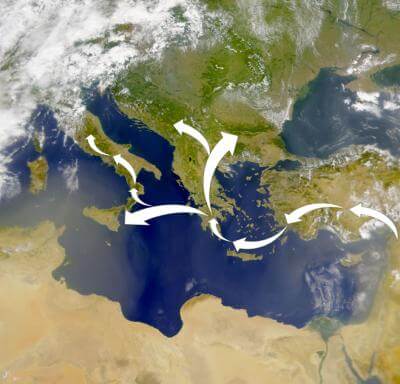This is revealed following the decoding of the mitochondrial genome of Neolithic skeletons from 10,000 years ago, whose skeletons were found in excavations in Damascus and its comparison with the mitochondrial DNA of the first farmers in Spain and Germany

Two separate genetic studies were published this week, and both deal with the migration of the first farmers from the area where Israel and its neighbors are located, mainly to Europe.
The Neolithic - a revolution in human society
Agriculture and permanent residences began to appear about 12 thousand years ago in the Fertile Crescent area. This period, known as Neolithic, constituted a social, cultural and economic change of the human population in aspects of agricultural production, a transition to an agricultural lifestyle, and the origin of the first cities and modern societies.
The question of how the Neolithic - the first people who developed agriculture and human culture - found their way to Europe has been the subject of a long-standing debate. Two separate studies may shed light on the issue.
The study: The Sea Routes of European Settlement" appeared in the June 6 online version of the journal PNAS of the American Academy of Sciences.
Between 10,000 and 8,800 BC in the Levant, the area in the Middle East that now includes Israel and the West Bank, Jordan, Syria, and part of southern Turkey, humans learned how to domesticate wild wheat. This achievement finally led them to abandon the nomadic life as hunter-gatherers and become farmers.
Archaeologists use this transition from hunter-gatherer to agriculture to mark the end of the Paleolithic, or Old Stone Age, and the beginning of the Neolithic, or New Stone Age.
Archaeological evidence reveals that by 7,000 BC the Neolithic people had moved into Europe. They introduced their ideas and genes to the indigenous Paleolithic population, which migrated to the continent 30-40 thousand years earlier.
The methods of transport and travel routes used by the Neolithic have been subject to debate. Did they move overland north from the Levant into Anatolia, an area that is now central Turkey, cross the Bosphorus and then enter central Europe through the Balkans? Or are they sailing at sea, and if so, on what routes. Did they cross directly from the Levant coast to Crete and from there to Greece, as another theory claims, or did they camp on the shores of Anatolia and hop from island to island between Turkey and Greece through the Dodecanese group, to Crete and from Crete to Greece to Europe?
To answer these questions, an international team of scientists led by George Stamatoyannopoulos, Professor of Medicine and Genomic Sciences at the University of Washington, studied the genetic markers of 32 modern populations from the Middle East, North Africa, Anatolia, the Aegean Islands and Crete, mainland Greece, southern and northern Europe .
In the study, Stamatoiannopoulos and his colleagues compared the ratios, or frequencies, of several markers called single nucleotide polymorphisms (SNPs) that appear in these different populations. When immigrants moved into an area and mixed with the local population, they introduced their genes into the native gene pool and acquired genes from the native population. This introduction of genes from one population to another is called "gene flow".

When subsequent generations continued to migrate and exchange genes, the phenomenon repeated itself again and again and therefore the frequency of SNPs in the immigrant population would reflect the genetic mixture. This is evident in the populations they left behind.
In the studies, the researchers hypothesized that the migration of the Neolithic to Europe was done through a sea voyage. They tested the hypothesis by comparing the frequencies of the SNPs in populations currently living in the Levant, Turkey, the Aegean Islands, and the rest of the Mediterranean, Europe and North Africa.
Their analysis confirmed that the Neolithic migrated through the Levant, north to Anatolia, crossing the Dodecanese to Crete and Laconia in the southwestern tip of Greece.
As the migration continued, some populations moved north to northern Greece, but most migration continued west to Sicily and the southern coast of Europe and from there to northern Europe.
"There were many Neolithic migrations into Europe. Some of them undoubtedly chose the land route, but the main route was to Anatolia and from there by sea to Crete, which served as the main route," Stamatoyannopoulos said.
Although this was not the focus of their study, the researchers also examined gene flow in populations in the Arabian Peninsula and North Africa. They found that Neolithic immigrants from the Near East also moved southwest to the Arabian Peninsula, and through present-day Egypt along the North African coast. However, no gene exchange was found between Africa and Europe, so the authors of the study speculate that although the sea allowed immigrants to move along the coasts, it served as a solid border between the two continents.
For the first time, the mitochondrial DNA of farmers from the Middle East has been deciphered. Experts examined the samples from three sites where Neolithic agriculture was born - the central Euphrates basin and the Damascus oasis, located in present-day Syria. The specimens date back to 8,000 BC.
The study, signed by researchers from the Department of Animal Biology at the University of Barcelona and many other partners from universities in Spain, was published in the journal PLOS Genetics. The genetic composition of the first Neolithic population remains a mystery to this day, although in the last decade there has been progress in the study of the genetics of the first European Neolithics. Prof. Daniel Turbon, also from the University of Barcelona, points to the fact that the findings published in the journal PLOS Genetics "are the first findings from farmers from the Middle East, or in other words, from the genetic pool of the original Neolithics, and they can be compared to previous findings in Catalonia, the Basque Country and Germany, but until Thus, no genetic comparison has been made between them and the original Neolithics from the Middle East, and we are doing this for the first time."
From the Near East to Europe
The new study provides a framework for interpreting the results of previous studies on Neolithic populations in Europe, the researchers say. The findings show a genetic affinity between the mitochondria of the original Neolithic populations and those of the first farmers from Catalonia and Germany. This indicates that the Neolithic spread through pioneer migrations of small population groups. Moreover, the two main migration routes - in the Middle East and in Europe may be linked by genetic proximity.
"The main finding" says Eva Fernandez, "is that the similarity between the populations in the Fertile Crescent and those in Cyprus and Crete supports the hypothesis that the Neolithic expansion in Europe occurred through pioneering seafarers and not through land migration through Anatolia, as was believed until now."
How did the Neolithic Revolution spread?
Other scientific studies have already provided evidence for the alternative scenario of Neolithic expansion in Europe, different from the passage through Anatolia. According to Tobron, "Recent archaeological findings have proven that the Neolithic came from Cyprus about 10,600 years ago, a few years after the first record of agriculture in the Far East. The agricultural models and burial methods discovered at sites in Cyprus are similar to those found in the central Euphrates basin, this indicates a direct settlement in these areas."
"In addition, radioactive carbon tests from various Neolithic sites in the Near East and Europe also confirm the hypothesis of the spread through Cyprus." He concludes.
The team members plan to analyze a larger number of Neolithic human samples from other areas of the Fertile Crescent in order to support their conclusions. In each sample they will test a greater number of genetic markers.
For news about the first study
For information about the second study

3 תגובות
The findings mentioned do not prove that the migrations 9000 years ago were done by sea. The places of settlement do not correspond to migration routes, the migrations last for a few months, while the settlement is only done in a few places of the migration routes. For example: it is possible to migrate from Greece to southern Italy through northern Italy but to have a settlement only in southern Italy (which is more convenient than northern Italy in terms of agriculture at least 5000 years ago and more when civilization was still primitive).
As for the populations settling in islands like Cyprus and Crete. If they could have been created only 4000 years ago then there were already primitive sailing vessels.
About the direct settlement of in these areas—per year for 8,000 years—or hear they swim in the sea = typos
There was a (controversial) plan called Atlantropia. It was a plan to build a dam on the Gilbert Strait. And generate electricity. In addition to lowering the level of the Mediterranean Sea, and drying up new territories. It could be that the Mediterranean Sea was lower in the past and it was easier to cross it. Only a lake at the time.